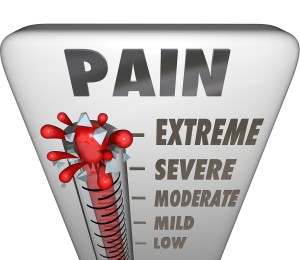How Do Chiropractors Measure Pain

Prior to chiropractic treatment, chiropractors must assess the amount of pain being experienced by a patient. However, unlike objective measures such as the degree of spinal curvature by Cobb angle with a scoliosis or the range of joint movement, assessing pain is somewhat subjective since there is no direct way to determine the degree of pain a patient is experiencing.
Instead, pain is reported from the patient and severity inferred from signs associated with it. These two methods—patient self-reporting and inference by examination—are the methods chiropractors use to assess a patient’s pain level.
While the degree of discomfort reported by a patient is an important guide, the subjective experience of pain means that each person will have a different level at which they call pain mild, moderate or severe. Patients will all have varying degrees of verbal and physical reactions to different levels of pain or soreness. Taken together, however, self-reporting and examination provide the chiropractor with a combination of evidence which can be used to determine pain levels with a reasonable degree of accuracy.
Most chiropractors treating a patient will use an assessment form that asks about the kind of problems the patient is experiencing and the amount of pain the problems are causing. A basic diagram of the body may be used to mark locations and levels of pain. Additional questions, either on a questionnaire or via patient interview, are used to ascertain the frequency of pain and the nature of movements and activities that trigger or exacerbate pain.
The level of perceived discomfort is often assessed using a pain scale in which the patient is asked to assign a figure to what they are experiencing, such as from 0 (no pain) to 10 (extreme pain). Although such a scale is subjective, most patients demonstrate internal consistency when it comes to reporting relative pain levels. This means that patient-reporting using this type of pain scale can be useful to determine whether a condition is responding to treatment over time or getting worse, as well as in determining how pain levels fluctuate over the course of a day or in response to certain kinds of activity. In addition to the simple pain scale, there are several specially designed questionnaires used to assess the degree of pain and disability associated with spinal injuries, such as the Quebec Back Pain Disability Scale.
Chiropractic assessment of a patient often begins when the patient walks through their local chiropractor’s door. A skilled chiropractor can tell much about a person’s well-being and how much pain someone is experiencing by their overall posture, gait, facial expressions of discomfort and involuntary verbalizations. While being examined, palpation and movement of problem areas will often trigger further articulations and/or tensing against painful movements which provide further clues regarding location and degree of discomfort. A chiropractor may use pain scales during the examination so that patients can communicate in a more focused way how much a certain movement or palpation hurts. Recording pain levels in the patient record provides a baseline measurement that a chiropractor uses to judge the effectiveness of treatment over time.
Pain measurement is an important method of assessing both the severity of an injury or condition and treatment progress. Pain is a clear sign that something is wrong and and impedes normal daily activities. In contrast, a reduction in pain following chiropractic therapy increases feelings of wellbeing and provides subjective evidence of improvement. For the chiropractor, this is an essential indication treatment is progressing as intended. Together with other signs such as increased strength, range of movement and endurance, reduced pain is a welcome indicator of successful chiropractic outcome.
In addition to patients from Woburn, Moramarco Chiropractic Office serves the local communities of Burlington, Wilmington, Reading, Winchester, Stoneham, Lexington and more. Area commuters appreciate our accessibility at the Route 38 Rotary in Woburn, Exit 35, near the 93/128 interchange. Contact us at 781-938-8558.
We take the best possible care of every patient who walks through our doors!
The best nonsurgical Scoliosis treatment available in North America!
We'll help you diagnose what's wrong and get you back to your life.


